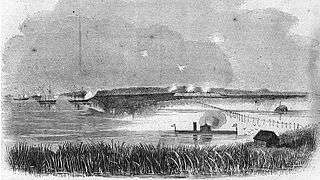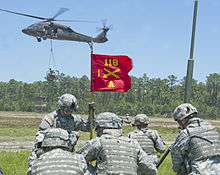Chatham Artillery
| Chatham Artillery | |
|---|---|
 Distinctive Unit Insignia: 118 FA | |
| Active | 1776–present |
| Country | United States |
| Allegiance |
|
| Branch |
|
| Type | Artillery |
| Size | Battalion |
| Garrison/HQ | Savannah, Georgia |
| Nickname(s) |
Savannah's Own (special designation)[1] Lightning Brigade (former) |
| Engagements |
American Revolution Sharper's Insurrection Oconee Wars War of 1812 Second Seminole War American Civil War World War I World War II Iraq Campaign Afghanistan Campaign |
| Decorations | Presidential Unit Citation, Meritorious Unit Commendation, French Croix de Guerre with Palm, Luxembourg Croix de Guerre, Belgian Fourragere |
| Commanders | |
| Notable commanders |
Thomas Lee Joseph Woodruff George Wayne Anderson |
The Chatham Artillery has played a leading role in the history of the state of Georgia since the American Revolution. in 1776 Thomas Lee was authorized to enlist a provincial company of artillery for the defense of Savannah, the first such unit in Georgia's history. Commanded by Joseph Woodruff, they defended the right flank of American forces when the British attacked Savannah. They saw service in the Oconnee wars, The Embargo Wars, and The War of 1812. They were part of the force that occupied Fort Pulaski that opened the American Civil War, and served in and around Savannah and Charleston SC before joining General Johnston's forces in Columbia, SC. After reorganization in 1872, they mustered out to the border with Mexico, to stop Pancho Villa's raids in the United States. They served with the "Dixie Division" in France during World War I, and landed on Normandy Beach on D-day plus 4 in World War II. They breached the Siegfried Line, and were at the Elbe River when the war ended. In 2005 they were mobilized again into federal service, as an element of the 48th Brigade Combat team serving in Iraq, part of Operation Iraqi Freedom. The Chatham Artillery was re-mobilized in 2009 to support Operation Enduring Freedom in Afghanistan, personally training Afghan Troops and Police Forces. They were demobilized in 2010 at Fort Stewart, GA. Today they remain in service, as a modular artillery brigade of the Georgia Army National Guard, the 118th Field Artillery.
As part of the 48th Infantry Brigade, the 118th FA is one of the oldest units in US Army history. It is one of few units in the US military that also saw service as a unit of the Confederate States of America during the US Civil War.
History and lineage
George Washington Visits Savannah in 1791
When George Washington visited Savannah on May 12, 1791, the Chatham Artillery saluted him with 26 discharges from their field guns. The company found such favor with the President, that he sent a gift of two field pieces captured at Yorktown on October 19, 1781. These "Washington Guns" are still on display in Savannah today near city hall. Two Historical Markers there outline the history of the guns.
Marker Number One:
These bronze cannon were presented to the Chatham Artillery by President Washington after his visit to Savannah in 1791. Of English and French make, respectively, they are excellent examples of the art of ordnance manufacture in the 18th century.
An inscription on the British 6 pounder states that it was "surrendered by the capitulation of York Town Oct. 19, 1781." The English cannon was cast in 1783 during the reign of George II and the royal insignia and motto of the Order of the Garter appear on its barrel.
The French gun was manufactured at Strasburg in 1756. On its elaborately engraved barrel appear the coat of arms of Louis XIV: the sun which was the emblem of that monarch, and a Latin inscription (which Louis XIV first ordered placed on French cannon) meaning "Last Argument of Kings." The dolphins were emblematic of the Dauphin of France. The gun was individually named "La Populaire."
Reminders of America's hard-won struggle for Independence and of the great man who led the Continental forces in the Revolution, the historic "Washington Guns" were placed on public display here through co-operation of the Chatham Artillery and the City of Savannah.
Marker Number Two:
These cannon, which were captured when Lord Cornwallis surrendered at Yorktown in the American Revolution, were a gift to the Chatham Artillery by President George Washington – a mark of his appreciation for the part the local military company played in the celebration of his visit to Savannah in May 1791. Washington commended the Chatham Artillery in "warmest terms" and at one of the functions in his honor (which took place on the river bluff east of this spot) proposed a toast "to the present dexterous Corps of Artillery."
The "Washington Guns" have thundered a welcome to many distinguished visitors to Savannah, including James Monroe, the Marquis de Lafayette, James K. Polk, Millard Fillmore, Chester A. Arthur, Jefferson Davis, Grover Cleveland, William McKinley, William H. Taft, and Franklin D. Roosevelt.
During the War Between the States the historic cannon were buried for safety beneath the Chatham Artillery armory and were not removed until 1872 when the Federal occupation troops had departed.
The guns were fired to salute President James Monroe when he visited Savannah in May 1819 for the launching of the S.S. Savannah, the first steamship to cross the Atlantic Ocean.
The "Washington Guns" were taken to Yorktown in 1881 by a contingent of the Chatham Artillery and led the parade at the centennial celebration of Cornwallis' surrender.
American Civil War
World War I
World War II
Operation Iraqi Freedom
Operation Enduring Freedom
Gallery
-
.tiff.jpg)
Chatham Artillery, 1786-1913, Savannah, Ga
-
Southern Wall Union Artillery damage 1862
-

Chatham Artillery building, with a cannon and revolutionary war figure on the roof, by Launey & Goebel
-

GA Savannah Fort Jackson
-

GA Savannah Fort Jackson gate
-

GA Savannah Fort Jackson
-
Fort McAllister today
-
Fort McAllister today
-
Fort McAllister today
-

Fort McAllister Tom Cat marker
-

USS Montauk Attacks Fort McAllister
-

Georgia Guard 118th Field Artillery
-

Georgia Guard 118th Field Artillery
References
- ↑ "Special Designation Listing". United States Army Center of Military History. April 21, 2010. Archived from the original on June 9, 2010. Retrieved July 14, 2010.
- Dixon, William Daniel and Durham, Roger S, The Blues in Gray – The Civil War Journal of William Daniel Dixon and the Republican Blues Daybook, University of Tennessee Press, 2000, ISBN 978-1-5723-3101-3
- Durham, Roger S., Guardian of Savannah – Fort McAllister, Georgia, in the Civil War and Beyond, The University of South Carolina Press, 2008, ISBN 978-1-5700-3742-9
- Christman, William E., UNDAUNTED: The History of Fort McAllister, Georgia, Darien Printing & Graphics, 1996, Library of Congress Catalog 96-77666 ASIN:
- Smith, Derek, Civil War Savannah, Frederic C. Beil, 1997, ISBN 978-1929490004
External links
- About Us: 48th Infantry Brigade Combat Team
- Washington Guns historical marker
- Washington Guns historical marker